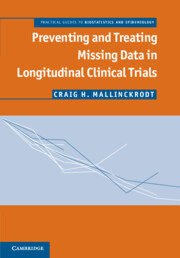Part III - Analytic Considerations
Published online by Cambridge University Press: 05 February 2013
Summary
Analytic Considerations
The merits of statistical analyses can be difficult to understand because there are several important aspects by which to describe the analyses. The common term used to name an analysis often reveals little about these key aspects. For example, it is not uncommon to hear an analysis described simply as last observation carried forward (LOCF). But LOCF is not an analytic method. It is a method for imputing missing values in which the last observed value is used to replace subsequent missing values.
Fully describing a statistical analysis for incomplete longitudinal data requires addressing three key aspects: (1) The method used to estimate the parameters (method); (2) what parameters are to be estimated (model); and (3) choice of data. Choice of data includes whether or not follow-up data are to be included in the analysis and/or by what means, if any, missing values are to be imputed.
This section begins with Chapter 6 that describes general aspects of common methods of estimation used in statistical analyses. While most statisticians will find this review unnecessary, for non-statisticians this material provides the framework necessary to understand different analytic methods, but it is not highly technical. Chapter 7 covers analytic models, with specific emphasis on how to decide what parameters need to be estimated. Chapter 8 outlines the various means of imputing or otherwise dealing with missing values, which is an important part of choosing data.
- Type
- Chapter
- Information
- Preventing and Treating Missing Data in Longitudinal Clinical TrialsA Practical Guide, pp. 37 - 38Publisher: Cambridge University PressPrint publication year: 2013



